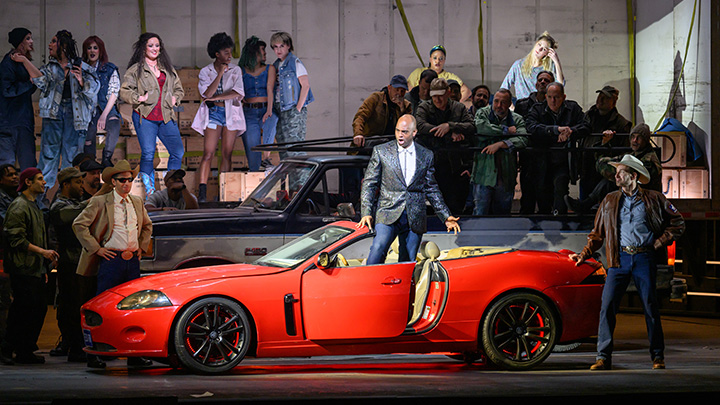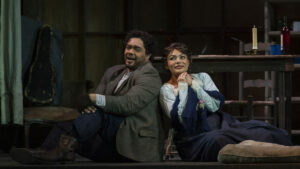And Carmen, with its endlessly beguiling score and titular antiheroine, is a strong enough piece to withstand any number of transformative interventions. Whether she’s been whisked away to a Cape Town township or plopped atop an ice rink, Carmen endures, even if (or, perhaps, because) no one can make up their mind about her.
Carrie Cracknell’s new production, now in the second half of its run at The Metropolitan Opera, attempts to foster the same sociopolitical immediacy that so scandalized the Parisian public. Best known for her work with the National Theatre and a positively dreadful adaptation of Jane Austen’s Persuasion for Netflix, the British director exchanges Southern Spain for an unspecified area presumably along the US Southern Border, trading Act I’s cigarette factory for a gun manufacturing plant, mules for pickup trucks, and toreadors for rodeo clowns. Certainly, the temptation to present Carmen à l’américaine is great, and in some instances the translation is fitting—what other opera closes its second act with a ragtag group of outsiders and rogues singing a paean to freedom? It has, however, been done before, most recently in Benjamin Millepied’s 2022 dance-heavy cinematic reimagining, which also takes place at the border.
Cracknell’s production is preoccupied with the darkness emerging from the fissures in contemporary American society. Children scamper around the gun plant on their razor scooters as good old boys in trucker hats loiter along the fence to leer at the women on the other side, Keystone Lights in hand. A baseball bat, that symbol of American leisure and heteronormative boyhood, becomes how a man kills the woman who dared to leave him. A garishly dressed group of rodeo-goers does the wave as that woman faces her end. The violence is pervasive and endless.

Each act opens with a series of projections by rocafilm and Roland Horvath with a silhouette of Carmen materializing from the shadows of chain-link fences and the men who patrol them. The silhouette presses her hands against the scrim, the lines on her palms becoming clearer as if probing the borders of her own world. A male silhouette—Don José— then creeps up behind her, either to embrace or throttle her. It does not matter which; each act casts her back into the shadows. Yet, the production takes an equally shadowy view of the people and country it purports to depict. The set designs by Michael Levine forgo geographic clarity in favor of neon lights and steel scaffolding while Tom Scutt’s costumes, which consist mainly of jeans, flannels, and rodeo jackets, amalgamate those onstage into a generic “red state” mass (though Carmen’s electric teal cowboy boots may prove iconic in time). This lack of specificity prevented the production from making any incisive commentary on our country’s current political situation or cultural identity. It gave us a Carmen With the Fringe On Top, but to what end?
Still, the production has an undeniable verve, especially in the Act II opening as Carmen and her fellow female outlaws ecstatically dance in the cab of a big rig amid a barrage of flashing lights. There, they seemed to imbibe the frenzied, exhilarating spirit of the highway, and the production came close to merging Bizet with something truly American.
Before curtain, it was announced that French mezzo-soprano Clémentine Margaine, our Carmen for the evening, was suffering from allergies, which likely contributed to some recurring pitch issues throughout the performance. The “Habanera” was particularly patchy, as she dropped the ends of several phrases while pushing through her congestion. Her voice had opened up significantly by Act III, where her treacle-toned lower register and some potent top notes emerged.
Margaine was a game presence onstage, clambering over gas pumps and into the backs of pickup trucks with relish in Act II and executing a series of impressive squats on a ledge during her seduction of Don José in the “Seguidille.” She portrayed Carmen as a woman intoxicated by her capacity to live on the edge, who relishes every opportunity to test the limits of those around her and prove her commitment to absolute personal freedom. Likewise, her vocal performance prioritized spontaneity and a willingness to take risks; she adopted a chanteuse-like approach, and she freely employed a nasal, straight tone at several points. I found this approach to be most effective during “Tra la la … Coupe-moi, brûle-moi” and “Je vais danser en votre honneur,” where it added a palpable sense of menace to these sing-songy passages. However, she also inserted many small yelps and squeals into the score, which punctured the sinews of Bizet’s melodies to little effect.
Margaine’s dramatic intensity was well-matched by Michael Fabiano’s Don José. As a performer, Fabiano seems to excel when he is permitted to take his characters to their absolute extremes. His Don José was as tightly wound as they come. He ogled Carmen and twitched in his seat throughout the Habanera. Here, we do not see an innocent soldier led astray by a dark woman, but an emotionally immature man grappling with anxiety and insecurities over his own dark desires. He’s a schlub with a pornstache and eyes that bulge out of his skull at the slightest affront.
Fabiano’s muscular tenor ensured a thrilling final confrontation with Carmen, but the intensity of his interpretation blunted the tenderer moments in the score, despite some lovely, floated notes during “Parle-moi de ma mère.” His “La fleur que tu m’avais jetée” was dynamically unvaried and rushed (in fact, there were several points where he and the orchestra were simply not together). A shimmering, well-sustained pianissimo B-flat at the end only teased what the aria could have been had he paced himself better.
Ailyn Pérez proved an ideal Micaëla, though I hope that her recent successes in leading roles at the Met mean that she can put this country lass behind her. Her pearly soprano gleamed during the Act I duet, and her excellent diction and luscious, pointed phrasing made the straightforward strains of “Je dis que rien ne m’épouvante” a highlight of the evening. She showed a considerable amount of vigor as she implored Don José to return to their village and attend to his dying mother, giving the usually meek Micaëla more of a spine. Hers was some of the most persuasive and consistent singing of the night. As Escamillo, Ryan Speedo Green cut a suave figure and carried off the bullfighter garb well, though his usually fulgent bass-baritone never quite caught fire during the tricky upward leaps of the Toreador Song. Still, he sang “Si tu m’aimes, Carmen” with a great deal of tenderness and sincerity.
Soprano Sydney Mancasola and Mezzo-Soprano Briana Hunter as Frasquita and Mercédès respectively lent charm and some much-needed humor to their exchanges in the Card Scene, along with genuine vocal luster. They paired well with the equally cohesive duo of Michael Adams’s Le Dancaïre and Frederick Ballentine’s Le Remendado. Benjamin Taylor lent an easy, warm sound to Moralès’s people-watching, while Wei Wu’s woolly baritone and stiff characterization did little to flesh out Zuniga.

Conductor Diego Matheuz, a graduate of Venezuela’s El Sistema and current Principal Conductor of La Fenice, made a promising company debut, eliciting a warm, rounded sound from The Metropolitan Opera Orchestra. He adopted an unfussy approach to the opera’s many dance rhythms and displayed a judicious control over the pit’s dynamic range: the orchestra displayed a seductively diaphanous quality during the factory workers’ entrance in Act I and opened “Les tringles des sistres tintaient” with a gentle, if mischievous, quality, that grew into a thunderous whirl. Matheuz proved an attentive presence throughout the opera’s many ensemble numbers, particularly in a well-balanced reading of the Smugglers’ Quintet. The Metropolitan Opera Chorus lent an array of colors to a staging dominated by shades of blacks and grays.
Despite the vocal and directorial unevenness, Carmen remains Carmen—and it leaves you wanting more.
Photos: Nina Wurtzel / Met Opera








Comments